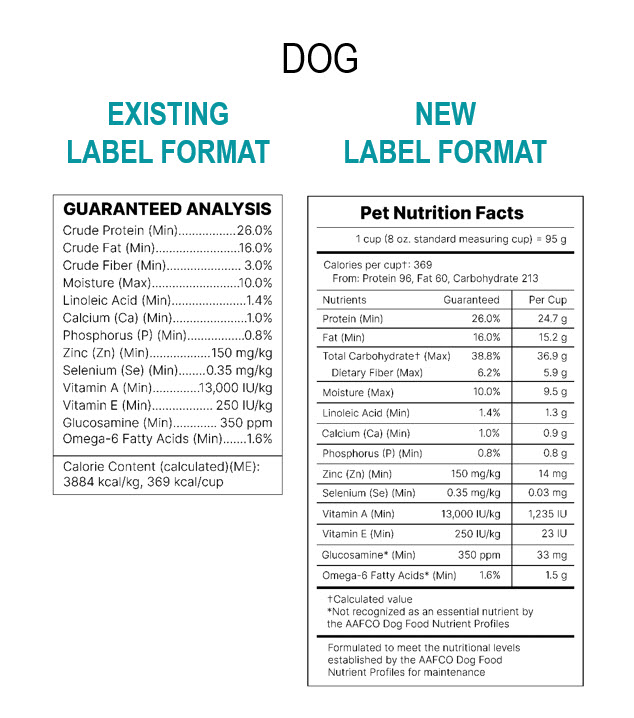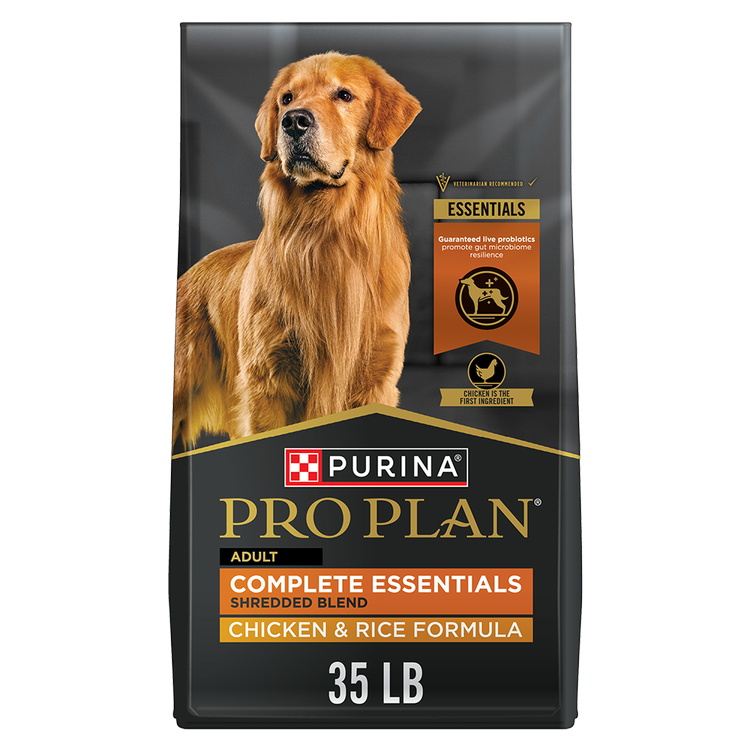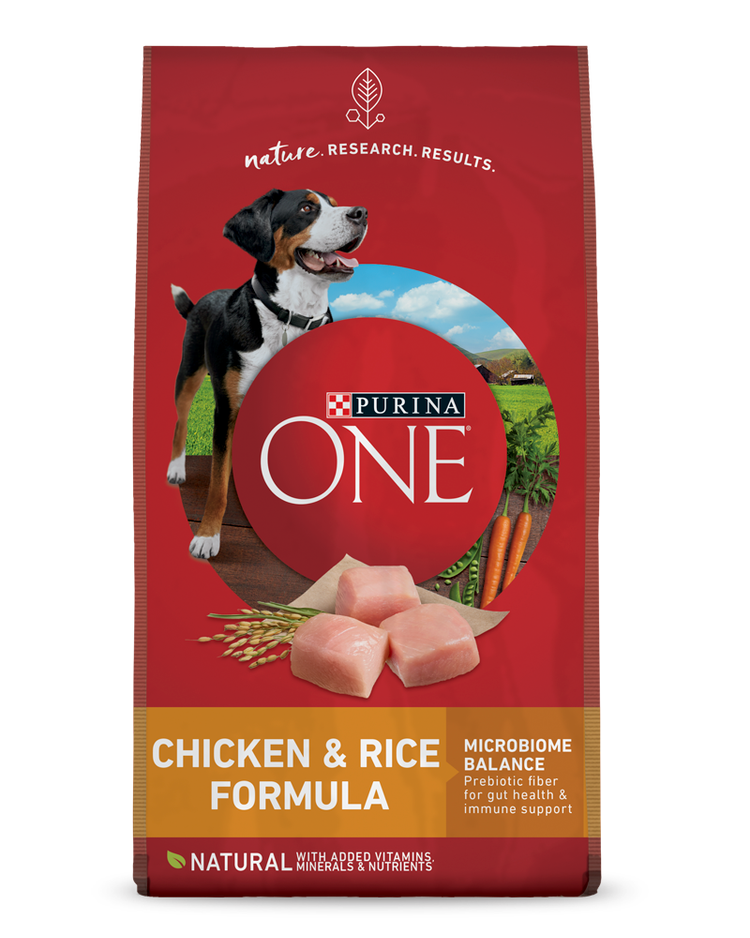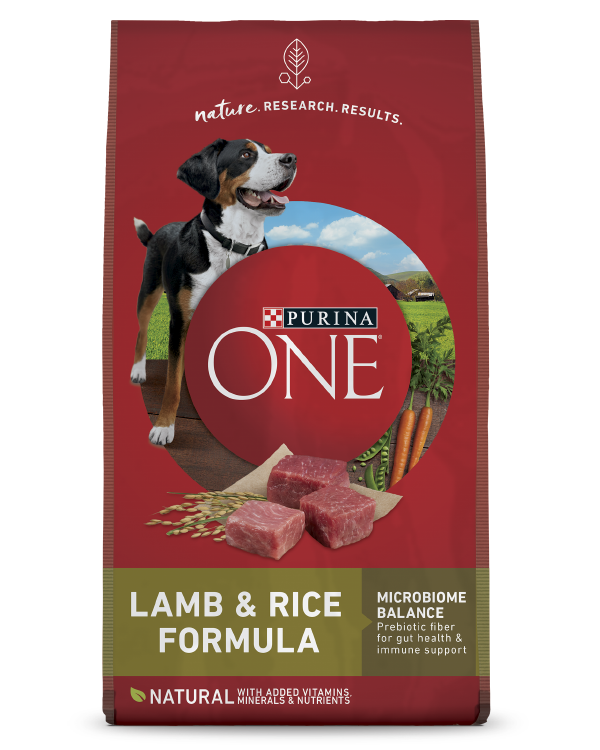
We have all felt those moments of standing in the aisles of a pet store and reading the endless lists of dog food labels wondering which one you should choose for your pup. Sometimes it can seem like you are reading a foreign language with all the numbers and confusing scientific terms. While pet food labels contain a lot of information, the good news is dog food analysis is easy once you know what you’re looking at.
To understand our pet food labels today, we need to go back a bit. See, in 2015 the Association of America Feed Control Official (AAFCO) began efforts for a Pet Food Label Modernization (PFLM) project, which is meant to make reading labels clearer, transparent, and easier to understand for all pet parents alike. As a result, you might notice that many labels on your favorite pet food brands have changed some. While this might create some concern, the truth is the changes are not as scary as you might think. In this article, we will compare the old and new labels and guide you on how to read and understand these newer labels, so you can make the best, informed decisions for your pets. Once you learn what certain claims mean, know a few key terms, and recognize which ingredients can play a key role in boosting your dog’s health, you’ll be ready to help your pal thrive with a healthy diet.
Old Labels vs. New Labels

There are 4 major label changes that will be required on all pet food labels:
- Nutrition Facts Box: The nutrient profile box of calories, guarantee analysis, percentages, and more have now been updated to be written similarly to human nutrition facts on food products.
- Ingredient Statement: This is the listed ingredients in a product, which have now been updated to clarify the use of parentheticals and naming conventions to make these lists easier to understand.
- Intended Use Statement: This identifies the life stage (ex: puppy, kitten, adult, senior, pregnant, or lactating), as well as the size and weight for the food which is intended.
- Handling and Storage: These are optional instructions to provide consumers with information on how to handle and store the pet food properly.
Before pet food labels had many different looks that was confusing and seemed to be somewhat disorganized. It was clear that there wasn’t a cohesiveness to pet food labels, creating a lot of confusion for consumers. However, now pet food labels are being asked to look more like human food labels to help us understand exactly what we are giving to our pet and how much we should feed them.
New labeling standards are being required to break down calories into proteins, fats, and carbohydrates. “Dietary fiber” percentages will now replace “crude fiber” percentages on packages, while vitamins and minerals will be allowed to provide their common names as well as their technical names to give pet parents a better idea of what they are giving to their dog.
Measurements units must now be in common household measurements, such as cups, treats, or pieces to make calculating out your buddy’s daily food intake easier. The front of the packages must let consumers know which life stage the food is for (ex: puppy, adult, or senior) and what the intended use of the product is for.
Food labels also have the option to let us know storage and handling directions, such as “refrigeration after opening” or whether we need to “wash our hands after handling the food”. In the following sections, we will break these labels down further so you can be a pro pet food label reader by the end of this guide.
Government Regulations Around Dog Food & Package Labels
According to regulations set forth by federal and state agencies, every package of dog food must contain the following items:
- Overview: The overview identifies the brand name (Like Purina Pro Plan or Purina Dog Chow). It may also give an indication of the primary ingredients or formula name, such as “chicken and rice.”
- Net Weight Statement: This states how much food is in the package.
- Nutrition Facts Box: This is an overview of the nutritional information in a package, including:
- Total calories
- Protein
- Fat
- Carbohydrates
- Dietary fiber
- Total weight in grams
- Serving size measurements
- Etc.
- Intended Use Statement: As mentioned above this is information displayed on the front of packages which identifies the life stage (ex: puppy, kitten, adult, senior, pregnant, or lactating), as well as the size and weight for the food which is intended.
- Manufacturer/Distributor Name & Address: This information tells you who made the food, so you can contact them with questions.
- Product Traceability Information: Based on the date code on a Purina dog food label, we can pinpoint the exact production date and the plant that produced that particular package.
- Expiration Date: This gives pet owners an indication for how long a particular package of dog food will be good for and at which point it has expired and should not be fed to a dog.
- Ingredient List: The ingredients on dog food labels are listed in descending order by content weight. If you see chicken listed as the first ingredient, for example, you’ll know your dog’s food has more chicken than any other ingredient on the list.
- Guaranteed Analysis: The guaranteed analysis on dog food labels shows the product’s nutrient content. It must include the minimum percentages of crude protein and crude fat as well as the maximum percentages of crude fiber and moisture. Including percentages for additional nutrients is voluntary, but they’re often included to indicate nutrient levels for benefits derived from the product (e.g.,: Calcium for strong bones and teeth.). The essential nutrients listed in the guaranteed analysis must meet (or exceed) the American Association of Feed Control Officials (AAFCO) nutrient profile standards.
- Nutritional Adequacy Statement: A dog food must meet or exceed the standards of an established nutrient profile to be marked “complete and balanced” for a particular life stage, such as adult maintenance or growth. Some products and dog foods are designed for intermittent or supplemental feeding and are not considered “complete and balanced.”
- Feeding Directions: These guidelines help you determine how much and how often to feed your dog every day. You may need to adjust the amount to maintain his ideal body condition based on his age, activity level and more. Feeding recommendations are also based on dogs not spayed or neutered. If yours has been fixed, you’ll want to account for that, too, says Purina veterinarian Dr. RuthAnn Lobos. Your dog’s veterinarian can help you determine how much to feed your dog.
- Calorie Statement: The calorie statement is expressed as kilocalories per kilogram and as a common unit of measure, such as kilocalories per cup. This will help you understand the caloric differences between dog food brands.
- Handling and Storage Instructions (optional): These instructions are meant to provide consumers with information on how to handle and store the pet food properly. For example, it might tell you whether the food needs to be refrigerated after opening, stored in a tight container after opening, or kept separate from human food. It might also mention handling directions, such as washing your hands after touching your pet’s food.
Nutrients vs. Ingredients on Dog Food Labels
“It’s nutrients, not ingredients when it comes to dog food and healthy dogs,” says Dr. Lobos. The ingredients in your dog’s food are important, but you should pay attention to the nutrients they provide.
The nutrients a complete and balanced dog food should include are:
- Protein: According to Dr. Lobos, “Protein is critical for metabolism, skin and coat and lean body mass. Protein also helps support a healthy immune system,” she says.
- Fat: When it comes to fat, Dr. Lobos says it protects the body, builds neurons and produces energy.
- Vitamins & Minerals: “Vitamins are body protectors while minerals are body builders and protectors,” says Dr. Lobos. “Dogs need 23 essential vitamins and minerals. So, you want to look for dog food labels that say they’re complete and balanced.” This means vitamins and minerals have been added to meet the dog’s nutritional needs.
- Carbohydrates: The various sources of carbohydrates in your dog’s food provide him with energy.
- Dietary Fiber: Fiber plays a key role in your dog’s GI system by ensuring that they are able to have regular bowel movements and good digestive health. Therefore, making sure that your buddy has the correct amount of fiber for your dog’s life stage becomes an important aspect to incorporate into their overall diet.
What About By-Products & Difficult-to-Pronounce Ingredients?
There are a lot of misconceptions about what by-products are. Many people believe they are cheap fillers or even inedible parts of other animals, but that’s not the case.
As Dr. Lobos explains, by-products are nutrient-rich organ meats that are less commonly consumed by humans. “By-products are not undesirable ingredients. Not only are by-products an excellent source of protein, vitamins and minerals, but they also reduce environmental waste.”
As far as those lengthy ingredient names go, a quick internet search can help. You’ll see that calcium pantothenate is vitamin B-5, thiamine mononitrate is vitamin B-1 and L-ascorbyl-2-polyphosphate is vitamin C.
Those ingredients are required to be listed by the scientific name for a vitamin or mineral, which are essential in helping maintain your dog’s health. To assist consumers, most companies also have the common names of these vitamins and minerals in parenthesis on their products.
Claims on Dog Food Labels
Regulations for human food and pet food are different. On a dog food label, “natural” means there are no chemically synthesized ingredients outside of vitamins, minerals and amino acids.
Of course, you’ll see those hard-to-pronounce, scientific names we mentioned above. You now know those are just the official names of vitamins and minerals, though – not something that doesn’t belong in your dog’s food.
“Formulated to meet” on a label means an analysis proves the food meets the nutrient profile standards. An “animal feeding test” means the product was fed to dogs using one of AAFCO’s feeding protocols. This validates the product meets the AAFCO nutrient profile for the life stage indicated on the package.
How to Decide Which Dog Food is Right for Your Dog
Having a better understanding of dog food labels allows you to better assess the various types of food available. As a result, you can confidently choose the one that best meets your dog’s needs. Comparing different types of dog food isn’t easy, but our experts can help.
For more expert tips, take our Pet Food Finder Quiz to see which selections are best for your loved one.

Find Your Pet’s Perfect Food
Get your personalized recommendation with our Pet Food Finder tool.








